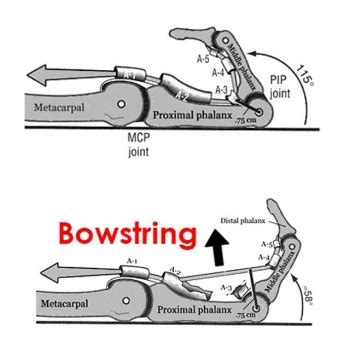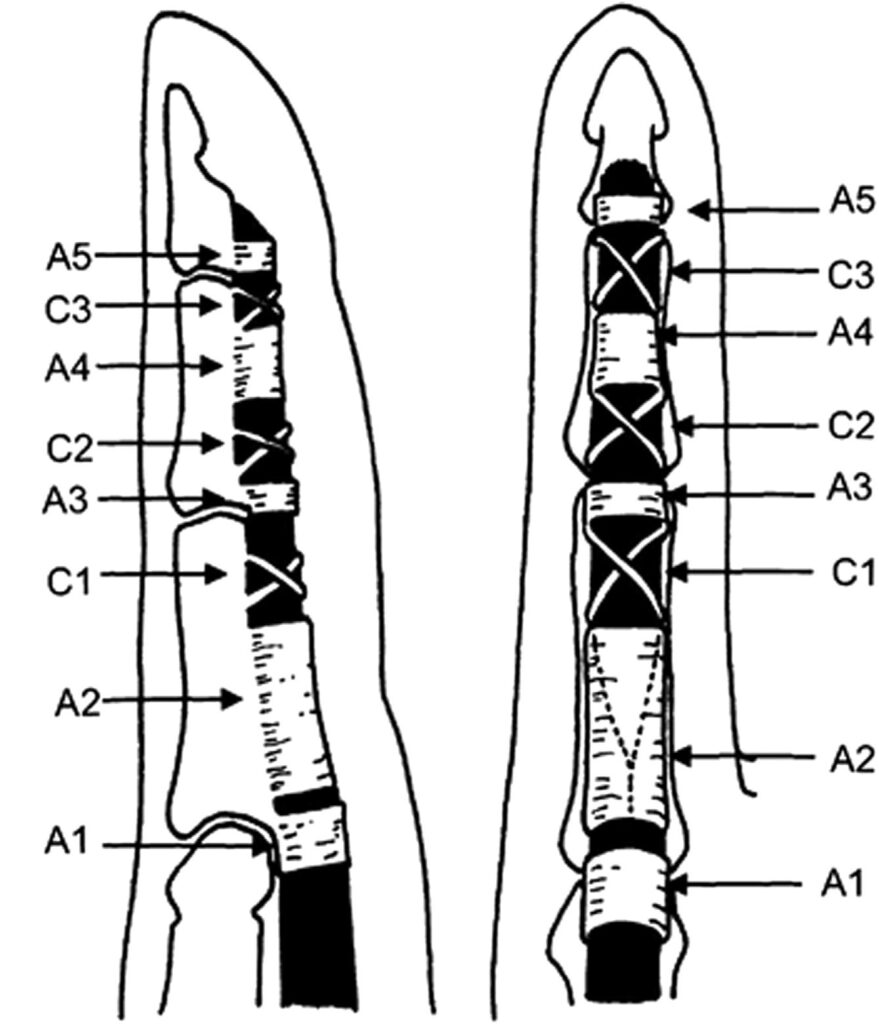A2 Pulley injuries are the most common form of annular ligament injuries and also the most common climbing injury. Ranging from minor tears to complete ruptures of the A2 ligament you’re in for a 2-12 week break from rock climbing. It depends on the severity of the injury and how well you can unload the injured finger by climbing easy routes, how long your climbing break is going to be.
I understand this might be a difficult moment for you, but it’s important you listen to your body and take a break. Get the right diagnosis and start treatment immediately for the best results.
To start you off, in this blog, I’m going to discuss what annular ligaments are, how pulley injuries occur, and how to heal them.
Let’s dive in!
1. What are Annular Ligaments?
The annular, meaning ring-like, ligaments of the fingers are a tight band that forms a ring around various parts of your fingers that help the flexor tendons stay in place. Without the annular ligaments, bowstringing would prevent you from effectively bending your fingers.

The thumb has 2 annular ligaments and all the other fingers have 5 annular ligaments. Each ligament is at the same spot on each finger and is named with a number going from A1 to A5.
Here is an overview of where you find each of the annular ligaments:
- A1: on top of the metacarpophalangeal (MCP) joint. This is the joint where your finger starts.
- A2: between MCP and the proximal interphalangeal joint (PIP). This is the area of the first phalanx.
- A3: on top of the PIP-joint.
- A4: on the middle phalanx.
- A5: on the distal interphalangeal joint (DIP).
In the thumb, you find the annular ligaments on the palmar side of the MCP and the IP joint.

As you can see in the image there are oblique ligaments in between the annular ligaments. If you look at their size and position, it’s clear that these ligaments have to resist less force and are therefore injured less often. And if they would be, it would be less of a problem. Moreover, in the image above you see all the ligaments nice and separated. In reality though, if you cut open a finger, you’ll find that the entire ligament system is more of a unified structure.
2. What is a Pulley Injury?
A pulley injury in the rock-climbing world is a partial to complete tear of the annular ligament and is the most common rock climbing injury there is. The pulley injuries often occur in the ring finger followed by the middle finger. The A2 ligament is most often torn and after that the A4 pulley.
Why is that?
Because these annular ligaments have to carry the highest load you crimp onto small holds. The typical cause of a pulley injury is when sudden eccentric loading of the annular ligaments occurs when the PIP joint is bent 90 degrees or more and the DIP joint is hyperextended. Situations that lead to sudden movements are often the breaking of holds and foot slips. Besides that, pulleys can also occur after periods of overtraining which cause microtraumas to the annular ligaments. As a result, you need less force to injury them.
3. How do You Know if You Have an A2 Pulley Injury?
There’s a high chance that you have a pulley injury if a situation like I described above occurs. A sudden foot slip or a hold that breaks off, with or without a popping noise in your finger. When the pulley injury is the result of microtrauma the pop can be subtle and there’s no need for a sudden movement.
Followed by the incident you’ll feel pain on the palmar side of the first phalanx and as you know now most likely in the ring or middle finger. Swelling might occur and depending on the severity of your A2 pulley injury it might be more or less hard to bend your finger. If the A2 ligament is entirely torn you might see bowstringing of the flexor tendon.
If you experience the symptoms described above make sure to confirm your pulley injury with ultrasound imaging.
4. How to Heal A2 Pulley Injuries?
Annular ligament injuries are divided into 4 grades, where grade I is the lightest form of a pulley injury and grade IV is the worst. The latter is a total rupture of the annular ligament and requires surgery if not treated correctly within the first week after injury. All other forms of pulley injuries can be treated conservatively.
So, what does a conservative treatment look like for let’s say, an A2 pulley injury?
- The first and most important thing to do is to get an orthosis for your finger. This is a plastic ring that is open on one side to ensure proper blood circulation. This ring will help to prevent bowstringing of the flexor tendon and ensure that your annular ligament regenerates as tightly as possible. This is important for the best outcomes because ligaments prevent movements and the stronger and tighter, they are the better they work. This ring-orthosis you have to wear day and night for best results.
- Anti-inflammatory medication might be an option, ask your doctor for advice on this subject
- It depends on the severity of your pulley injury how and when you can start rock climbing again
In the table below you will find an overview of how and when to load your fingers again. This is an adoption of Schöffl et al 2004b.

I know of doctors here in the area that don’t recommend physiotherapy after pulley injuries. You get the orthosis and wait for the pulley injury to heal and start climbing when that is done.
Nevertheless, I believe that physiotherapy might help you with the following:
- Building a loading program that suits your needs
- Revising your training program (if your pulley injury is the result of repetitive microtraumas)
- Identifying muscle imbalances and treating them
- Radial shockwave can enhance the healing and/or reduce the pain of the pulley ligament
5. Important Take-Aways
An A2 Pulley injury is a common rock climbing injury and depending on the severity of the injury means at least a month of no rock climbing. Make sure you see a specialist that can use ultrasound imaging on your finger to confirm the diagnosis. Then look at the table above to see what you’re in for. In my opinion, you’ll have the best results in your rehab with a combination of ring-orthosis and physiotherapy. Make sure to talk to a physiotherapist who specializes in rock climbing to ensure he or she has the required knowledge to help you.
